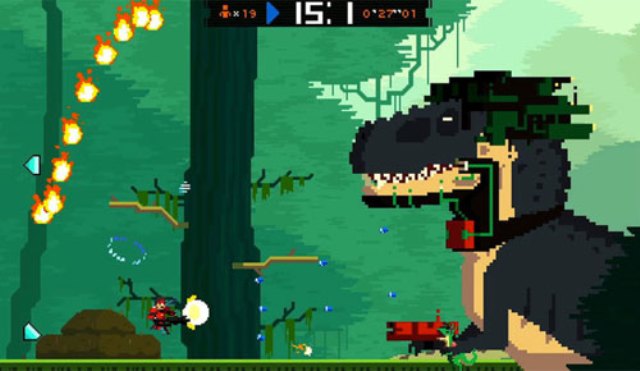How Super Time Force developers redefined metaphysics
One of the best things about video games is creating impossible realities, but common notions of reality became a nuisance when Capy was making Super Time Force. It’s a side-scrolling action shooter in which you can gang up on enemies on the fly by creating multiple timelines. However, we personally experience only one timeline, so temporal paradoxes don’t come to mind until someone makes them into an interactive system. We have talked a little bit about this before, but at GDC, Capy Technical Director Kenneth Yeung disclosed to Gamasutra a few more details about the challenges and solutions devised throughout the evolution of Super Time Force.
Joking, Yeung said, “I got 99 problems and time is 100 of them.”
“We wanted to make something simple, easy, a fun action game,” Yeung continued. “But in reality, when you’re dealing with time, you’re dealing with something that’s complex and paradox-filled.”
As a result, Capy needed to create a new system of metaphysics to avoid messy paradoxes and keep the game fair and fun. “You can have a solid engine and idea,” Yeung explained, “but without these solid systems in place, your game will for sure break down.” As it turns out, those systems push a little further than your high school physics class curriculum.
Capy designed three constant rules: causality violation, butterfly effect management and quantum measurement problem. It’s confusing, but here are the general ideas:
Causality violation means that while the game could process each timeline in rigid, causal systems, it instead tethers two entities across time and space to key events in other timelines. In other words, if something important happens in one timeline, it also happens in a parallel timeline regardless of how your newest timeline progresses. For example, if you collect a powerup in one timeline, you will get it again in a new timeline even if you play differently. This violates causality in a way that favors the player so that earned progress stays earned.
The butterfly effect is managing the fallout in future events when the past is changed. Yeung cautioned, “When you alter the past, you cause everything in the future to play out differently. Ninety-nine percent of the time it’s going to be detrimental.”
To manage it all, Capy turned to the second law of thermodynamics to redefine equilibrium in entropy. To favor the player, equilibrium prioritizes enemies to be neutralized and allies to be saved. Yeung explains that, “any modifications to the timeline must never cause past enemies to be better off, or cause allies to be worse off.” This way, your change in a new timeline will not ruin your progress in an older timeline. For example, say in one timeline you jump off a platform before it collapses. If you rewind time and jump off the platform sooner than in your first timeline, you will not cause your first timeline character to fall to his/her death.
Quantum measurement is most easily explained by the classic question: if a tree falls in the woods and nobody hears it, does it still make a sound? As far as Super Time Force goes, the answer is no. What you see is what exists, meaning that variables like off-screen enemies, bullets and structures are eliminated so as not to complicate your interaction. Doing this keeps the game’s flow under your control.
While these metaphysical laws are not entirely logical in our reality, they preserve the awesome time-traveling mechanic that makes Super Time Force so fun. After all, Yeung concludes, “feel is more important than being logical.”
Super Time Force is coming to Xbox 360 and Xbox One. We still don’t have a release date, but Capy has previously promised it would be sometime in early 2014. To better understand the game, you can learn the basics from this trailer.
Source: Gamasutra

